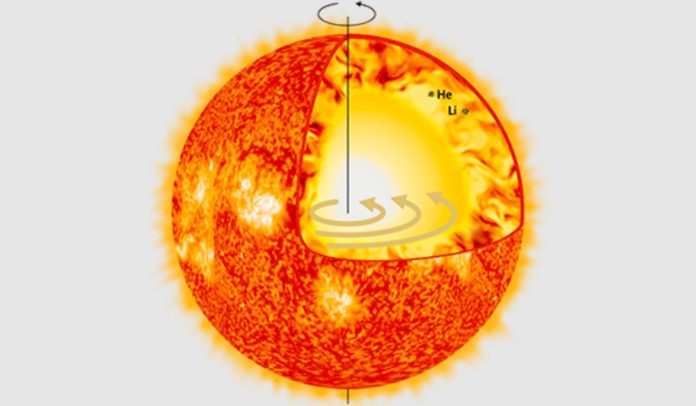A fresh collection of data in the early 2000s brought the chemical abundances at the Sun’s surface down, contradicting the numbers predicted by astrophysicists’ traditional models.
These new abundances survived multiple new analyses despite being frequently contested. Since they seemed to be right, it was up to the solar models to change, especially since they are used to studying other stars.
Scientists from Switzerland’s University of Geneva (UNIGE) and Belgium’s Université de Liège (UL) have come up with an explanation for the structure of the Sun’s chemical composition by taking into account the Sun’s rotation and magnetic fields, which have changed over time.
The findings of this research were reported in the journal Nature Astronomy.
“The Sun is the star that we can best characterise, so it constitutes a fundamental test for our understanding of stellar physics,” explains Patrick Eggenberger, the study’s first author. “We have abundance measurements of its chemical elements, but also measurements of its internal structure, like in the case of Earth thanks to seismology.”
These observations should match the results predicted by the models that try to explain how the Sun has changed over time. How does the Sun’s hydrogen get burned in its core? What is the process through which energy is generated and subsequently delivered to the surface? How are chemical elements affected by rotation and magnetic fields as they move within the Sun?
The most common solar model
“The standard solar model we used until now considers our star in a very simplified manner,” adds Gal Buldgen, co-author of the study, “on the one hand with regard to the transport of the chemical elements in the deepest layers, on the other hand for the rotation and the internal magnetic fields that were entirely neglected until now.”
Everything was good until the early 2000s, when an international scientific team, aided by enhanced research, drastically changed solar abundances. The new abundances shook the solar modeling seas to their core.
Since then, no model has been able to replicate the data provided by helioseismology (the study of the Sun’s oscillations), particularly the helium abundance in the solar envelope.
New model, rotation, and magnetic fields
The UNIGE team’s new solar model incorporates not only the evolution of rotation, which was most likely faster in the past but also the magnetic instabilities it causes.
As explained by Patrick Eggenberger: “We must absolutely consider simultaneously the effects of rotation and magnetic fields on the transport of chemical elements in our stellar models.”
Adding: “It is important for the Sun as for stellar physics in general and has a direct impact on the chemical evolution of the Universe, given that the chemical elements that are crucial for life on Earth are cooked in the core of the stars.”
According to the authors, not only does the new model accurately anticipate the concentration of helium in the Sun’s outer layers, but it also represents the concentration of lithium, which had previously eluded modeling.
“The abundance of helium is correctly reproduced by the new model because the internal rotation of the Sun imposed by the magnetic fields generates a turbulent mixing which prevents this element from falling too quickly towards the centre of the star; simultaneously,” Patrick Eggenberger adds “the abundance of lithium observed on the solar surface is also reproduced because this same mixing transports it to the hot regions where it is destroyed.”
The problem hasn’t been fully fixed
But the new model doesn’t solve every problem that helioseismology has brought up: “Thanks to helioseismology, we know within 500 km in which region the convective movements of matter begin, 199,500 km below the surface of the Sun. However, the theoretical models of the Sun predict a depth offset of 10,000 km! ” says Sébastien Salmon, UNIGE researcher and co-author of the article.
If the problem is still there after using the new model, it gives us a new way to think about it: “Thanks to the new model, we shed light on the physical processes that can help us resolve this critical difference.”
Solar-type star update
“We are going to have to revise the masses,” adds Gal Buldgen, “radii and ages obtained for the solar-type stars that we have studied so far” as next steps.
In most situations, solar physics is applied to case studies that take place close to the Sun. As a result, if the models for analyzing the Sun are updated, the same update must be done for other stars that are comparable to ours.
“This is particularly important if we want to better characterise the host stars of planets, for example within the framework of the PLATO mission,” says Patrick Eggenberger.
In 2026, this observatory of 24 telescopes will fly to Lagrange point 2 (1.5 million kilometers from Earth, opposite the Sun) to discover and characterize tiny planets as well as refine the properties of their host star.
Image Credit: Getty
You were reading: Scientists Think They Have Solved Part of the “solar Problem”
